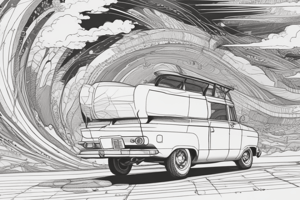Podcast
Questions and Answers
Which type of line is described as composed of a series of dots?
Which type of line is described as composed of a series of dots?
- Curved Line
- Zigzag Line
- Straight Line
- Dotted Line (correct)
What is a defining characteristic of geometric shapes?
What is a defining characteristic of geometric shapes?
- They can only be circles or squares.
- They change shape based on context.
- They are irregular and free-form.
- They have precise measurements. (correct)
Which color is NOT considered a primary color?
Which color is NOT considered a primary color?
- Blue
- Red
- Green (correct)
- Yellow
What does the term 'negative space' refer to in design?
What does the term 'negative space' refer to in design?
What is saturation in terms of color properties?
What is saturation in terms of color properties?
Which type of shape is commonly associated with natural forms?
Which type of shape is commonly associated with natural forms?
What is a tertiary color?
What is a tertiary color?
Which combination of colors results in a visually harmonious effect?
Which combination of colors results in a visually harmonious effect?
Flashcards are hidden until you start studying
Study Notes
MAPEH Study Notes: Lines, Shapes, Colors
Lines
- Definition: A line is a continuous mark made on a surface, having length but negligible width.
- Types of Lines:
- Straight Lines: Direct and uncurved; can be horizontal, vertical, or diagonal.
- Curved Lines: Bend in a smooth, flowing manner; includes circles and arcs.
- Zigzag Lines: Formed by a series of short, connected lines that change direction sharply.
- Dotted Lines: Composed of a series of dots; can indicate movement or separation.
- Line Quality: Can vary in thickness, texture, and style, conveying different emotions and meanings.
- Function: Used in drawing and design to create form, lead the eye, and structure composition.
Shapes
- Definition: A shape is a two-dimensional area defined by boundaries; can be geometric or organic.
- Types of Shapes:
- Geometric Shapes: Regular shapes such as squares, circles, triangles, and rectangles with precise measurements.
- Organic Shapes: Irregular, free-form shapes found in nature, such as leaves and clouds.
- Shape Properties:
- Size: The dimensions of the shape can affect its impact in a composition.
- Color: Shapes can gain emphasis and meaning through color association.
- Negative Space: Area around and between shapes, important for balance and composition.
- Function: Shapes can organize space, create patterns, and convey concepts or themes.
Colors
- Definition: Color is the visual perception resulting from the way objects reflect or emit light.
- Color Wheel: A circular diagram representing the spectrum of colors, used to understand color relationships.
- Primary Colors: Red, blue, yellow; cannot be created by mixing other colors.
- Secondary Colors: Green, orange, purple; formed by mixing primary colors.
- Tertiary Colors: Result from mixing primary and secondary colors.
- Color Properties:
- Hue: The name of the color (e.g., red, blue).
- Saturation: The intensity or purity of a color; a highly saturated color is vivid, while a desaturated color is more muted.
- Value: The lightness or darkness of a color; adding white creates tints, adding black creates shades.
- Color Psychology: Colors can evoke emotions and convey messages; e.g., red for passion, blue for calmness.
- Color Harmony: Combinations of colors that are visually appealing; includes complementary, analogous, and triadic schemes.
Summary
- Lines, shapes, and colors are fundamental elements of art and design.
- Understanding these elements helps create effective visual compositions and convey messages.
Lines
- A line is a continuous mark characterized by length and negligible width.
- Types of lines include:
- Straight lines: Direct and uncurved, can be horizontal, vertical, or diagonal.
- Curved lines: Bend smoothly, including forms like circles and arcs.
- Zigzag lines: Composed of short connected lines that sharply change direction.
- Dotted lines: Made up of dots, indicating movement or separation.
- Line quality varies in thickness, texture, and style, influencing the emotions conveyed.
- Lines serve to create form, direct the viewer’s eye, and structure the composition in art.
Shapes
- A shape is a two-dimensional area defined by boundaries, categorized as geometric or organic.
- Types of shapes include:
- Geometric shapes: Regular forms such as squares, circles, and triangles with precise dimensions.
- Organic shapes: Irregular, free-form configurations resembling natural elements like leaves and clouds.
- Properties affecting shapes:
- Size impacts the visual weight and influence within a composition.
- Color emphasizes shapes and contributes to their meaning.
- Negative space, the area surrounding shapes, is critical for achieving balance.
- Shapes organize space, create patterns, and convey themes effectively.
Colors
- Color is the visual perception resulting from light reflection or emission from objects.
- The color wheel displays the spectrum of colors and helps understand their relationships.
- Primary colors (red, blue, yellow) cannot be created by mixing others.
- Secondary colors (green, orange, purple) result from mixing two primary colors.
- Tertiary colors arise from mixing primary and secondary colors.
- Properties of color include:
- Hue: The name describing the color (e.g., red, blue).
- Saturation: Color intensity or purity; high saturation results in vivid hues, while low saturation leads to muted tones.
- Value: Lightness or darkness of a color, with tints created by adding white and shades by adding black.
- Color psychology indicates that colors evoke emotions; e.g., red signifies passion, while blue represents calmness.
- Color harmony involves visually appealing combinations of colors, including complementary, analogous, and triadic schemes.
Summary
- Lines, shapes, and colors are essential elements in art and design.
- Mastery of these components enhances the ability to create impactful visual compositions and effectively communicate messages.
Studying That Suits You
Use AI to generate personalized quizzes and flashcards to suit your learning preferences.




